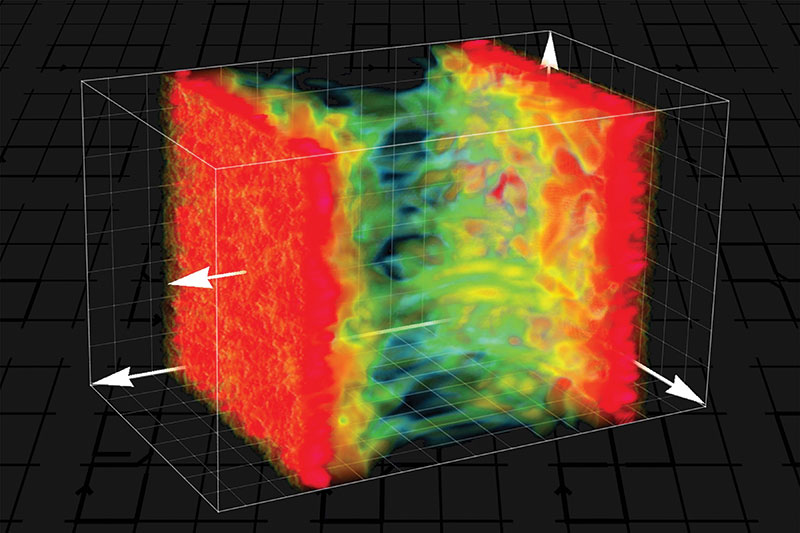Machine Learning, Physics, and Your Future
Spring
2022
Feature
Machine Learning, Physics, and Your Future
Kendra Redmond, Editor
We live in a data-driven world. When you buy coffee, retweet, binge watch, search, or walk near a security camera, your behaviors and choices become part of the data landscape. You know that already, and you also know that data is valuable. But you may not know that all this data, in combination with advances in semiconductor computation devices, has given physicists and astronomers the opportunity to make a big impact on society in the form of machine learning.
Machine learning is a tool for making sense of data, and it lies at the intersection of physics and astronomy skills, job opportunities, and change-the-world potential. It’s what’s under the hood of today’s photo filters, autonomous cars, online fraud detection programs, and language translation software. It’s powering cutting-edge research on disease detection and treatment, extreme weather prediction, and other big challenges facing society.

Machine learning 101
A subset of artificial intelligence (AI), machine learning describes a system in which an algorithm, or set of algorithms, learns from data and adapts.
Physicists and astronomers traditionally use their knowledge of a system to build a model. By running simulations and comparing the results with real data, they uncover what’s happening in the physical system. Machine learning flips that approach, says Michelle Kuchera, a computational physicist and assistant professor at Davidson College. The machine learning approach says, “I’m not going to make assumptions about the model. I’m going to learn from the data, let it tell me something,” she says.
In practice, this involves starting with an algorithm or set of algorithms appropriate for the task. Next comes training the model with lots of existing data. As the model learns, the algorithm evolves to better accomplish its task when it meets new data.
For example, if you want to identify cats and dogs in pictures, you start with a classification algorithm. You train the algorithm with lots of pictures of cats and dogs, telling it which is which. Through this process the algorithm learns the difference between cats and dogs and, in response, self-adapts to distinguish between them. A well-trained system can then accurately classify the subjects of new pictures as cats or dogs―even though you never defined the difference.
You can think of machine learning as pattern matching, says Vijay Janapa Reddi, an associate professor of engineering and applied science at Harvard University. With a machine learning system, you “implicitly let it learn the pattern that’s inherently in the data, rather than explicitly code rules to identify a pattern that you may not even be aware exists,” he says.

What does that have to do with physics and Astronomy?
Machine learning is a powerful tool for physics and astronomy research. Browse a journal like Applied Physics Letters or Astrophysical Journal Letters and you’ll find physicists and astronomers applying machine learning to tasks such as predicting the characteristics of new materials, fabricating qubits, identifying stellar objects, and finding anomalies in massive data sets.
“If you look at the Large Hadron Collider, or any such scientific instrument, there’s a lot of fine-tuning that needs to happen in real time to precisely control them. It’s great to be able to do that using machine learning . . . you’ll be able to infer very complex control patterns much more easily,” says Janapa Reddi.
If you choose a career in physics and astronomy research, you’ll probably be applying machine learning or collaborating with someone who is before too long. It’s not magic, but machine learning can handle many situations that are difficult for conventional methods. It’s another tool in the physicist’s toolbox.
“Machine learning is really great for cases where you don’t have an algorithm with explicit rules on how to accomplish a certain task,” says Kuchera. She says it’s also great for discovery―looking for patterns, outliers, or unexpected behavior in data, and for making fast theoretical predictions.
Machine learning is essential for physics and astronomy research in other ways too. In its early days, machine learning was done at large-scale data centers, but now the technology has moved into our phones and homes—think Alexa and Siri. It’s not cost effective, energy efficient, or at times even practical to move all this data into the cloud for processing. As a result, the machine learning community is pushing to the edge, moving the data processing or computation as close as possible to the actual data.
At the forefront of machine learning research is something called tiny machine learning, or tinyML. It’s the concept of running machine learning models at the point of data collection using ultralow power. This enables always-on sensors or other devices that can operate for years without recharging. And when it comes to next-generation particle accelerators and other huge scientific instruments that will operate in real time with many moving parts, we'll need this technology. “There is absolutely no way you can stream this data to some cloud computing model,” says Janapa Reddi. It won’t even be possible to move the data off the device, because the real-time latencies will interfere with the integrity of the data, he says.
If you’re thinking about a future in industry, machine learning is worth considering. According to Sandeep Giri, a staff project manager at Google, there are all kinds of technical and nontechnical career paths in the machine learning and AI space, from software engineering to hardware design, systems engineering, supply chain, operations, product and project management, sales and business development, and beyond. People with a physics and astronomy background can and do grow into all these careers, he says. You don’t need a graduate degree, and there are tons of jobs. “I believe that every tinyML company, large Fortune 500 or startup, involved in energy-efficient machine learning is hiring like crazy,” says Evgeni Gousev, senior director at Qualcomm Technologies, Inc.


I’m not qualified for that. Am I?
Physics students and academic physicists often tell Gousev that they’d like to work in industry, but they don’t see themselves as qualified. This is just a “perceived barrier,” says Gousev. He says most physics and astronomy undergrads can pick up the basics of machine learning in a matter of months. That’s because they already have the math background, real-world data experience, training in logical problem-solving, and the ability to look at the world and connect the dots.
Physicists are also good at asking critical questions, and that’s especially needed in this emerging field, says Giri. What and where is the problem? What are possible solutions? Should we even be solving this problem? Who else might utilize this solution? What biases and inequities might emerge if this method is used on other data sets, like data on people?
If you’re interested in pursuing machine learning, the first step is to develop confidence in yourself and your background, says Sean Grullon, lead AI scientist at Proscia. Then, he suggests reading machine learning blogs to get a feel for the vocabulary and what researchers are working on. “If that kind of stuff excites you, then it’s a good indication that you should investigate it further,” Grullon says. From there, he suggests learning basic Python, if you haven’t already, and then exploring project examples and online classes.
Janapa Reddi notes that it’s also important to learn all you can about data collection, data engineering, and evaluating results. He says that system architecting is one of the biggest challenges in industry today and the reason many startups fail. A good model is worthless if you don’t understand how it works in the field. “It’s one thing to get a nice accuracy number on a chart in your notebook; it’s a whole different thing when you put it into practice in the real world,” he says.
As a community that only loves cows when they’re spherical, that’s definitely something all physicists know. //
This article is adapted in part from “A Physicist’s Guide to Machine Learning and Its Opportunities,” which appeared in the Spring 2022 issue of Radiations.
